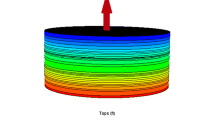Abstract
One of the most critical quantities for characterizing a gas condensate reservoir is dew point pressure. But, accurate determination of dew point pressure is a very challengeable task in reservoir development. Experimental measurement of dew point pressure in PVT (Pressure, Volume, Temperature) cell is often difficult, especially in the case of lean retrograde gas condensate. So, different empirical correlations and equations of state are developed by researchers to calculate this property. Empirical correlations do not have ability to reliably duplicate the temperature behavior of constant composition fluids, and equations of state have convergence problem and need to be tuned against some experimental data. In addition, these approaches are not generalizable to unseen data, and they usually memorize the data used to develop them. In this paper, we develop an intelligent model to predict dew point pressure of gas condensate reservoirs using Gaussian processes optimized by particle swarm optimization. The developed model is generalizable and can estimate unseen data with the same distribution of training data accurately. Results show that the proposed method in this paper outperforms the previous published models and correlations.






Similar content being viewed by others
References
A modified particle swarm optimizer (1998) doi:10.1109/ICEC.1998.699146
Amiri S, Mehrnia MR, Barzegari D, Yazdani A (2011) An artificial neural network for prediction of gas holdup in bubble columns with oily solutions. Neural Comput Appl 20:487–494. doi:10.1007/s00521-011-0566-x
Bertsimas D, Nohadani O (2010) Robust optimization with simulated annealing. J Glob Optim 48(2):323-334. doi:10.1007/s10898-009-9496-x
Carison M, Cawston W (1996) Obtaining pvt data for very sour retrograde gas and volatile oil reservoirs: a muti-disciplinary approach. SPE gas technology symposium, Calgary, Alberta, Canada, 28 Apr–1 May 1996
Cessie SL, Houwelingen JCV (1992) Ridge estimators in logistic regression. Appl Stat 41(1):191–201. doi:10.2307/2347628
Colorni A, Dorigo M, Maniezzo V (1991) Distributed optimization by ant colonies. In: Proceedings of ECAL91—European conference on artificial life. Elsevier, Amsterdam
Cristianini N, Shawe-Taylor J (2000) An introduction to support vector machines and other Kernel-based learning methods. Cambridge University Press, Cambridge
Danesh A (1998) PVT and phase behavior of petroleum reservoir fluids. Elsevier, Amsterdam
Darwiche PA (2009) Modeling and reasoning with Bayesian networks, 1st edn. Cambridge University Press, New York
Dorigo M, Stützle T (2004) Ant colony optimization. Bradford Company, Scituate
Elsharkawy A (2002) Predicting the dew point pressure for gas condensate reservoir: empirical models and equations of state. Fluid Phase Equilib 193:147–165
Fausett L (ed) (1994) Fundamentals of neural networks: architectures, algorithms, and applications. Prentice-Hall, Upper Saddle River
Goldberg DE (1989) Genetic algorithms in search, optimization and machine learning, 1st edn. Addison-Wesley, Boston
Hall M, Frank E, Holmes G, Pfahringer B, Reutemann P, Witten IH (2009) The weka data mining software: an update. SIGKDD Explor Newsl 11(1):10–18. doi:10.1145/1656274.1656278
Hall MA (1999) Correlation-based feature selection for machine learning. Master’s thesis
Han J, Kamber M (2006) Data mining:concepts and techniques. Morgan Kaufmann, Los Altos
Kennedy J, Eberhart R (2002) Particle swarm optimization. In: Proceedings of the IEEE international conference on neural networks, 1995, vol 4, pp 1942–1948. doi:10.1109/ICNN.1995.488968
Khandelwal M (2011) Application of an expert system to predict thermal conductivity of rocks. Neural Comput Appl (2011). doi:10.1007/s00521-011-0573-y
Marrufo I, Maita J, Him J, Rojas G (2001) Statistical forecast models to determine retrograde dew pressure and c +7 percentage of gas condensates on basis of production test date of eastern venezuelan reservoirs. SPE Latin American and Caribbean petroleum engineering conference, Buenos Aires, Argentina, 25–28 Mar 2001
Mathworks: Matlab (2010) http://www.mathworks.com
Mierswa I, Wurst M, Klinkenberg R, Scholz M, Euler T (2006) Yale: rapid prototyping for complex data mining tasks. In: Ungar L, Craven M, Gunopulos D, Eliassi-Rad T (eds) KDD ’06: proceedings of the 12th ACM SIGKDD international conference on Knowledge discovery and data mining. ACM, New York, pp 935–940
Nemeth L, Kennedy H (1967) A correlation of dew point pressure with fluid composition and temperature. SPEJ 7(2):11477
Nowroozi S, Ranjbar M, Hashemipour H, Schaffie M (2009) Development of a neural fuzzy system for advanced prediction of dew point pressure in gas condensate reservoirs. Fuel Process Technol 90:452–457
Poli R, Kennedy J, Blackwell T (2007) Particle swarm optimization. Swarm Intell 1(1):33–57. doi:10.1007/s11721-007-0002-0
Potsch K, Braeuer L (1996) A novel graphical method for determining dew point pressure of gas condensates. SPE European petroleum conference, Milan, Italy, 22–24 October 1996
Ramaswamy S, Rastogi R, Shim K (2000) Efficient algorithms for mining outliers from large data sets. In: Proceedings of the 2000 ACM SIGMOD international conference on Management of data. ACM
Rasmussen CE, Williams CK (2006) Gaussian process for machine learning. MIT Press, Cambridge
Ustn B, Melssen W, Buydens L (2006) Facilitating the application of support vector regression by using a universal pearson vii function based kernel. Chemom Intell Lab Syst 81:29–40
Yin XC, Liu Q, Hao HW, Wang ZB, Huang K (2011) Fmi image based rock structure classification using classifier combination. Neural Comput Appl 20(7):955–963
Acknowledgments
This work is supported by a grant from research department of Persian Gulf University of Bushehr.
Author information
Authors and Affiliations
Corresponding author
Rights and permissions
About this article
Cite this article
Rostami, H., Khaksar Manshad, A. Application of evolutionary Gaussian processes regression by particle swarm optimization for prediction of dew point pressure in gas condensate reservoirs. Neural Comput & Applic 24, 705–713 (2014). https://doi.org/10.1007/s00521-012-1275-9
Received:
Accepted:
Published:
Issue Date:
DOI: https://doi.org/10.1007/s00521-012-1275-9




